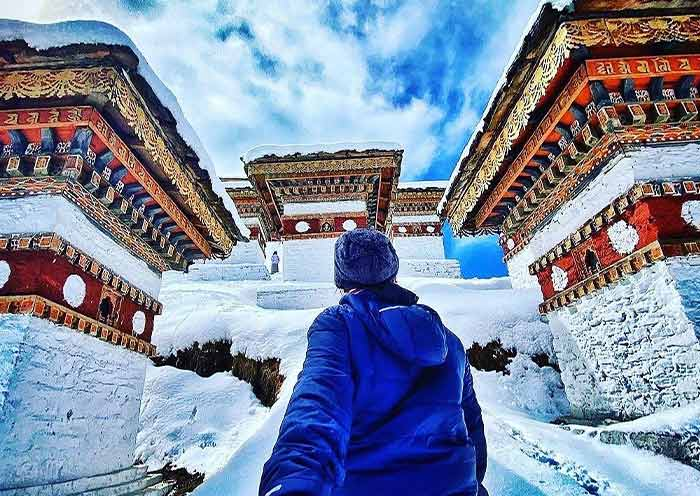Discover Bhutan in Winter: A 7-Day Adventure
Nestled in the eastern Himalayas, Bhutan is a mystical land where tradition and modernity coexist harmoniously. Known for its stunning landscapes, rich cultural heritage, and commitment to happiness, Bhutan offers a unique experience for travelers. While most visitors flock to Bhutan during the spring and autumn months, a winter visit has its own charm. The snow-dusted peaks, tranquil monasteries, and the serene beauty of this Buddhist kingdom make it an ideal destination for those seeking both adventure and peace. If you're planning a 7-day trip to Bhutan in winter, here's a guide to some of the best things to do.
Day 1: Arrival in Paro and Exploration
Your journey begins as you land in Paro, home to Bhutan’s only international airport. The flight into Paro is an adventure in itself, offering breathtaking views of the Himalayan range. After settling in, start your exploration with a visit to the Rinpung Dzong, a fortress-monastery that offers insight into Bhutanese culture and history. The dzong's stunning architecture and its strategic location overlooking the Paro River make it a must-visit. In winter, the snow-covered peaks in the backdrop add to the mesmerizing beauty.
Afterward, take a stroll through Paro town to experience local life. Visit some of the local handicraft shops, where you can find traditional Bhutanese crafts, textiles, and souvenirs.
Day 2: Hike to Tiger’s Nest Monastery
The highlight of any trip to Bhutan is undoubtedly the hike to the Taktsang Monastery, commonly known as the Tiger’s Nest. Perched precariously on a cliff 900 meters above the Paro Valley, this sacred site is where Guru Rinpoche is said to have meditated in the 8th century. The hike is challenging, especially in winter when the trail may be snow-covered, but the reward is worth every step. The monastery looks like something out of a fairy tale, with the snow adding an ethereal quality to the experience.
Day 3: Journey to Thimphu
On the third day of your 7-day trip to Bhutan, travel to Thimphu, the capital city. The journey takes about 1.5 hours, offering scenic views of the countryside. Upon arrival, visit the National Memorial Chorten, a stupa built in memory of the third king of Bhutan. The chorten is a center of daily worship for many Bhutanese, and its whitewashed walls and golden spire are especially beautiful against the winter sky.
Next, visit the Buddha Dordenma, a massive statue overlooking the Thimphu Valley. Standing 51.5 meters tall, this statue of Buddha is one of the largest in the world. In winter, the surrounding mountains are often snow-capped, adding to the spiritual ambiance.
Day 4: Explore Thimphu’s Cultural Sites
Dedicate this day to exploring Thimphu’s rich cultural heritage. Start with a visit to the Tashichho Dzong, the seat of the Bhutanese government and the king’s office. This fortress-monastery is an architectural marvel, and during winter, the surrounding gardens are peaceful and less crowded.
Next, head to the Folk Heritage Museum, where you can learn about traditional Bhutanese life. The museum is housed in a 19th-century farmhouse, giving you a glimpse into the past. Don't miss the National Textile Museum, where you can admire the intricate handwoven textiles that Bhutan is famous for.
Day 5: Dochula Pass and Punakha
On day five, embark on a journey to Punakha, the former capital of Bhutan. En route, stop at Dochula Pass (3,100 meters), which offers panoramic views of the Himalayan range. In winter, the pass is often blanketed in snow, and the sight of the 108 chortens (stupas) at the pass is breathtaking.
Upon reaching Punakha, visit the Punakha Dzong, often considered the most beautiful dzong in Bhutan. Located at the confluence of the Pho Chhu and Mo Chhu rivers, the dzong’s whitewashed walls, intricately carved woodwork, and scenic setting make it a photographer’s paradise.
Day 6: Explore Phobjikha Valley
No winter trip to Bhutan is complete without visiting the Phobjikha Valley, a glacial valley known for its natural beauty and as the winter home of the endangered black-necked cranes. The valley is a haven for nature lovers, with its wide, open spaces and rolling hills. In winter, the landscape is transformed into a serene, snow-covered wonderland.
Visit the Gangtey Monastery, one of the oldest and most important Nyingma monasteries in Bhutan. The monastery overlooks the valley, offering stunning views. The Phobjikha Valley is also perfect for nature walks, where you can enjoy the peace and quiet of this remote region.
Day 7: Return to Paro and Departure
On the final day of your 7-day trip to Bhutan, return to Paro. Depending on your flight schedule, you can spend some time revisiting your favorite spots in Paro or simply relaxing and reflecting on your journey. Bhutan’s winter landscapes, rich cultural experiences, and warm hospitality make it a destination like no other.
Conclusion
A winter trip to Bhutan offers a unique perspective on this Himalayan kingdom. The snow-covered peaks, peaceful monasteries, and rich cultural experiences create an unforgettable journey. Whether you're hiking to the Tiger’s Nest, exploring the capital city of Thimphu, or enjoying the serene beauty of Phobjikha Valley, Bhutan in winter is a dream come true for any traveler. So pack your bags and embark on a 7-day trip to Bhutan—an adventure you'll cherish for a lifetime.



Comments
Post a Comment